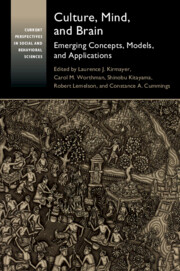Book contents
- Culture, Mind, and Brain
- Current Perspectives in Social and Behavioral Sciences
- Culture, Mind, and Brain
- Copyright page
- Dedication
- Epigraph
- Contents
- Figures
- Tables
- Contributors
- Preface
- Abbreviations
- 1 Introduction
- Part I Dynamics of Culture, Mind, and Brain
- Section 1 The Co-emergence of Culture, Mind, and Brain
- Section 2 The Situated Brain
- 5 Culture in Mind – An Enactivist Account
- 6 The Brain as a Cultural Artifact
- 7 Cultural Priming Effects and the Human Brain
- 8 Culture, Self, and Agency
- Section 3 How Social Coordination and Cooperation are Achieved
- Part II Applications
- Index
- References
5 - Culture in Mind – An Enactivist Account
Not Cognitive Penetration but Cultural Permeation
from Section 2 - The Situated Brain
Published online by Cambridge University Press: 18 September 2020
- Culture, Mind, and Brain
- Current Perspectives in Social and Behavioral Sciences
- Culture, Mind, and Brain
- Copyright page
- Dedication
- Epigraph
- Contents
- Figures
- Tables
- Contributors
- Preface
- Abbreviations
- 1 Introduction
- Part I Dynamics of Culture, Mind, and Brain
- Section 1 The Co-emergence of Culture, Mind, and Brain
- Section 2 The Situated Brain
- 5 Culture in Mind – An Enactivist Account
- 6 The Brain as a Cultural Artifact
- 7 Cultural Priming Effects and the Human Brain
- 8 Culture, Self, and Agency
- Section 3 How Social Coordination and Cooperation are Achieved
- Part II Applications
- Index
- References
Summary
Advancing a radically enactive account of cognition, this chapter argues for the possibility that cultural factors permeate rather than penetrate cognition such that cognition extensively and transactionally incorporates cultural factors in lieu of there being any question of cultural factors having to break into the restricted confines of cognition. We review the limitations of two classical cognitivist, modularist accounts of cognition in addition to a revisionary new order variant of cognitivism – a predictive processing account of cognition (PPC). We argue that the cognitivist interpretation of PPC is conservatively and problematically attached to the idea of inner models and stored knowledge. Instead, we offer a radically enactive alternative account of how cultural factors matter to cognition – one that abandons all vestiges of the idea that cultural factors might contentfully communicate with basic forms of cognition. In place of that idea, we promote the possibility that culture permeates cognition.
Keywords
- Type
- Chapter
- Information
- Culture, Mind, and BrainEmerging Concepts, Models, and Applications, pp. 163 - 187Publisher: Cambridge University PressPrint publication year: 2020



